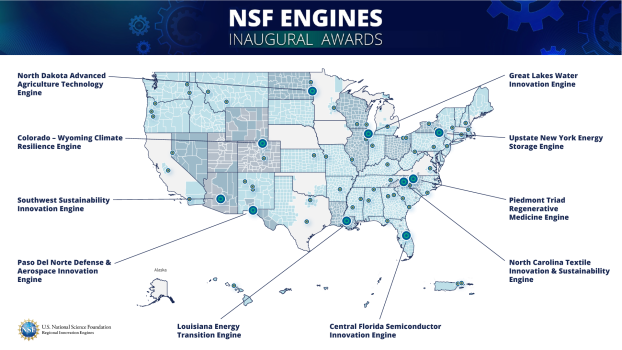In January 2024, the U.S. National Science Foundation established the first-ever NSF Regional Innovation Engines (NSF Engines), awarding 10 teams spanning 18 states.
 On this page
On this page
Types of awards
The NSF Engines program makes awards in two categories: NSF Engines development awards and NSF Engines awards.
NSF Engines awards: Up to $160 million and up to 10 years
- NSF Engines awards fund NSF Engines across three distinct phases — the nascent, emergent and growth phases.
- Throughout the three phases, the NSF Engine:
- Creates firm partner and stakeholder commitments.
- Seeks continuing growth of its innovation ecosystem through expansion of scientific, technical, education and workforce development.
- Helps its regional innovation ecosystem emerge as a national leader in its topic area during the growth phase. .
NSF Engines development awards: Up to $1 million and up to two years
- NSF Engines development awards enable awardees to lay the groundwork for establishing a new NSF Engine in their region for a given topic area.
- This award begins and ends in the development phase, where the NSF Engine develops its structure and scope and begins to establish partnerships.
- At the end of the NSF Engines development award period, awardees are expected to be well-prepared to set up an NSF Engine in the nascent phase.
Note: the NSF Engines program is not making development awards during the 2024 round of the competition but previous development awardees are eligible to compete in the open competition.
NSF Engines awards
Visit each NSF Engine's page or download the NSF Engines Booklet (updated July 2024) to learn more about its work and competitive advantage, lead organization, region of service and technology topic areas.
10 inaugural NSF Engines:
- NSF Engines: Central Florida Semiconductor Innovation Engine
- NSF Engines: Colorado–Wyoming Climate Resilience Engine
- NSF Engines: Great Lakes Water Innovation Engine
- NSF Engines: Louisiana Energy Transition Engine
- NSF Engines: North Carolina Textile Innovation and Sustainability Engine
- NSF Engines: North Dakota Advanced Agriculture Technology Engine
- NSF Engines: Paso del Norte Defense and Aerospace Innovation Engine
- NSF Engines: Piedmont Triad Regenerative Medicine Engine
- NSF Engines: Southwest Sustainability Innovation Engine
- NSF Engines: Upstate New York Energy Storage Engine
NSF Engines development awards
In May 2023, NSF awarded the first-ever NSF Engines development awards to 44 teams. In April 2024, NSF awarded another 14 development awards to a subset of the NSF Engines semifinalists and finalists, bringing the total to 58. Learn more about the NSF Engines development awards.
NSF Engines review and selection information
The first-ever NSF Engines awards to 10 teams span 18 states. To learn more about the NSF Engines winners, read the announcement and view map of the NSF Engines.
How will NSF determine which NSF Engines receive funding beyond two years?
NSF will use several factors to determine if an NSF Engine should receive continued funding after year two, including progress toward their milestones and use-inspired research, translation and workforce development goals.
Because these are cooperative agreements, each NSF Engine will develop its milestones in consultation with a team of NSF Engines program directors. Additionally, each NSF Engine will provide the agency with regular reports on a quarterly basis.
During the first two years, the NSF program team will travel to the awardee communities annually for a site visit to better understand what progress looks like on the ground.
NSF will evaluate the cohesiveness of the Engine's team and ecosystem, with a particular focus on its governance model and execution by leadership. All these factors, plus inputs from subject-matter experts inside and outside the agency, will guide the NSF program team in making decisions on the next installment of funding for the current class of awardees.
To be eligible for funding after year two, each NSF Engine will be assessed on its ability to show progress toward the NSF Engines programmatic goals. Minimally, this includes:
- Meaningful progress towards development of a sustainable, STEM-based innovation ecosystem — centered around long-term economic impact.
- A commitment to enabling all Americans to engage in innovation, economic growth, and new career pathways.
- Having all components of its five-year strategic and implementation plan approved by NSF by month 15.
- Meeting all general and award-specific terms and conditions, as determined by the NSF program team.
In addition to the above factors, continued NSF investment in an NSF Engine depends upon the availability of funds.


